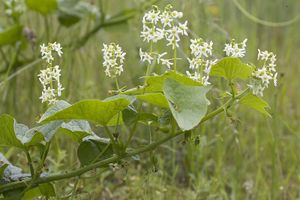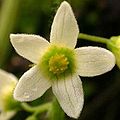Difference between revisions of "Marah oregana"
m (Tag: VisualEditor) |
m (Tag: VisualEditor) |
||
| Line 23: | Line 23: | ||
==Description== | ==Description== | ||
| − | + | Native perennial, trailing or climbing with tendrils. | |
| − | + | Leaves are alternate, palmately lobed, rough and hairy, and cordate at the base. | |
| − | + | ||
| − | + | ||
| − | + | Flowers are unisexual, corolla campanulate and white, monoecious. | |
| − | + | ||
| − | + | ||
| − | + | The bladder-like fruits are sparsely to densely covered with flexible prickles that harden with age, dehiscent at apex when dry. <ref>Bowcutt, F., & Hamman, Sarah. (2016). ''Vascular plants | |
| − | + | of the South Sound prairies'' (First ed.). Olympia, Washington: The Evergreen | |
| + | State College Press.</ref> | ||
| − | + | ==Bloom Period== | |
| − | + | ||
| − | + | ||
| − | + | ||
| − | + | ||
| − | + | ||
| − | + | ||
| − | + | ||
| − | + | ||
| − | + | ||
| − | + | ||
| − | + | ||
| − | + | ||
| − | + | ||
| − | + | ||
| − | + | ||
| − | + | ||
| − | + | ||
| − | + | ||
| − | + | ||
| − | + | ||
| − | + | ||
| − | + | ||
| + | ==Distribution== | ||
| + | ==Habitat== | ||
| + | ==Uses == | ||
| + | ==Propogation== | ||
===Seed=== | ===Seed=== | ||
| Line 86: | Line 65: | ||
==Photo Gallery== | ==Photo Gallery== | ||
<gallery> | <gallery> | ||
| − | File:MAOR BenLegler sdh good.jpg | + | File:MAOR BenLegler sdh good.jpg|Fruit, photo by Ben Legler |
| − | File:MAOR BenLegler flw avg.jpg | + | File:MAOR BenLegler flw avg.jpg| Flower, photo by Ben Legler |
</gallery> | </gallery> | ||
Revision as of 11:21, 5 June 2020
- Latin Name: Marah oregana
- Family: Cucurbitaceae
- Common Names: coastal manroot, wild cucumber
- Synonyms/Misapplications: Echinocystis oregana, Marah oreganus, Sicyos oregana, Megarrhiza oregana, Micrampelis
oregana - Codon: MARORE
Contents
Taxonomy
| Marah oregana | |
|---|---|

| |
| Photo by Rod Gilbert, also featured on Main Page | |
| Scientific classification | |
| Kingdom: | Plantae |
| Subkingdom: | Tracheobionta |
| Phylum: | Spermatophyta |
| Subphylum: | Magnoliophyta |
| Class: | Magnoliopsida |
| Subclass: | Rosanae |
| Order: | Cucurbitales |
| Family: | Cucurbitaceae |
| Genus: | Marah Kellogg |
| Species: | Marah oregana (Torr. ex A. Gray) Howell |
Description
Native perennial, trailing or climbing with tendrils.
Leaves are alternate, palmately lobed, rough and hairy, and cordate at the base.
Flowers are unisexual, corolla campanulate and white, monoecious.
The bladder-like fruits are sparsely to densely covered with flexible prickles that harden with age, dehiscent at apex when dry. [1]
Bloom Period
Distribution
Habitat
Uses
Propogation
Seed
Seed sample from: 2011
Average Measurement: 16.8 x 17 x 8.5
Measurement Range: L: 15 – 18, W: 16 – 18, D: 8 – 9
Features
Shape: Seeds very large, rounded with a pinched looking hilum.
Color: Dark brown, with a lighter brown hilum. Under high magnification seed appears speckled with black.
Surface: Seed covered in very fine velvety hairs. Under high magnification seed appears slightly glossy, but with naked eye, seed is matte.
Latitudinal Cross Section: elliptical ![]()
Longitudinal Cross Section: elliptical ![]()
References
Photo Gallery
- ↑ Bowcutt, F., & Hamman, Sarah. (2016). Vascular plants of the South Sound prairies (First ed.). Olympia, Washington: The Evergreen State College Press.


